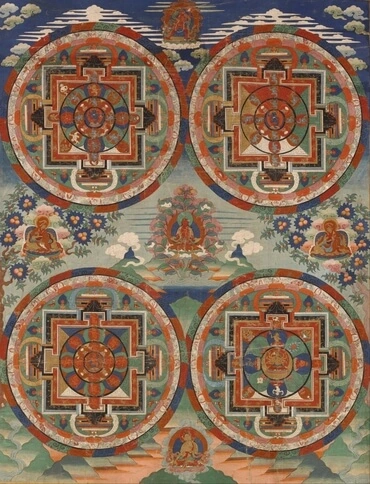1
Därefter förde han mig till tempelsalen. Och han mätte murpelarna de voro sex alnar breda, var på sin sida -- tabernaklets bredd.
2
Och ingången var tio alnar bred, och sidoväggarna vid ingången voro på var sida fem alnar. Sedan mätte han salens längd: den var fyrtio alnar, och dess bredd: den var tjugu alnar.
3
Därefter gick han in i det innersta rummet. Och han mätte murpelarna vid ingången: de höllo två alnar, och ingången: den höll sex alnar, och ingångens bredd: den var sju alnar.
4
Och han mätte dess längd: den var tjugu alnar, och dess bredd: den var tjugu alnar, framför tempelsalen. Och han sade till mig: »Detta är det allraheligaste.»
5
Därefter mätte han husets mur: den höll sex alnar, och sidokamrarnas bredd: den var fyra alnar, runt omkring hela huset.
6
Och sidokamrarna lågo den ena ovanför den andra, i trettiotre omgångar; och på den mur som sträckte sig innanför sidokamrarna runt omkring funnos avsatser, på vilka de skulle hava sitt fäste; ty i själva husväggen skulle de icke vara infästa.
7
Härigenom blevo sidokamrarna, där de lågo kring huset, bredare alltefter som de lågo högre upp. Ty husets kringbyggnad sträckte sig med övervåning ovanpå övervåning runt omkring huset. Därför växte bredden inåt, alltefter som våningen låg högre upp. Och från den nedersta våningen steg man så upp i den översta genom den mellersta.
8
Och jag såg att huset låg på en upphöjd fot, som sträckte sig runt däromkring; sidokamrarnas grundvalar voro nämligen en hel stång höga, sex alnar till kanten.
9
Sidokamrarnas yttermur var fem alnar tjock; och den plats som blev fri tillhörde husets sidokamrar.
10
Och mellanrummet bort till tempelkamrarna var tjugu alnar brett runt omkring hela huset.
11
Och ingångarna till sidokamrarna lågo utåt den fria platsen, en ingång mot norr och en ingång åt söder; den fria platsen var fem alnar bred, runt omkring.
12
Och den byggnad som låg invid den avsöndrade platsen på västra sidan var sjuttio alnar bred, och byggnadens mur var fem alnar tjock runt omkring och nittio alnar lång.
13
Och han mätte huset: det var hundra alnar långt. Och den avsöndrade platsen jämte byggnaden med dess murar utgjorde en längd av hundra alnar.
14
Och bredden på husets framsida jämte den avsöndrade platsen åt öster utgjorde en längd av hundra alnar.
15
Och han mätte längden på den byggnad som låg invid den avsöndrade platsen, på dennas baksida, och mätte avsatserna på dess framvägg åt båda sidor -- de höllo hundra alnar -- vidare det inre tempelrummet och förgårdsförhusen,
16
trösklarna och de slutna fönstren, avsatserna på framväggen runt omkring, i deras tre våningar, platsen invid tröskeln -- som var av polerat trä -- runt omkring,
17
så ock avståndet från marken upp till fönstren. Och fönstren voro täckta. Men ovanför dörren, både in emot det inre rummet och utåt, och eljest utefter hela väggen runt omkring, innantill och utantill, funnos avmätta fält,
18
på vilka framställdes keruber och palmer, var palm mellan två keruber. Och var kerub hade två ansikten:
19
ett människoansikte åt palmen på ena sidan, och ett lejonansikte åt palmen på andra sidan; så var gjort på hela huset runt omkring.
20
Från marken ända upp över ingången funnos keruber och palmer framställda, så ock på tempelsalens väggar.
21
Tempelsalens dörröppning var fyrkantig, och framsidan av det heligaste hade sitt givna utseende.
22
Altaret var av trä, tre alnar högt och två alnar långt, och det hade hörn; och dess långsidor och väggar voro av trä. Och han talade till mig: »Detta är det bord som skall stå inför HERRENS ansikte.»
23
Och både tempelsalen och det heligaste hade dubbeldörrar.
24
Och var dörr hade två dörrskivor, två vridbara dörrskivor: den ena dörren hade två dörrskivor, och likaledes den andra två.
25
Och på dem, på dörrarna till tempelsalen, funnos framställda keruber och palmer, likasom på väggarna; och på förhusets framsida, utantill, var ett trapphus av trä.
26
Och slutna fönster och palmer funnos på förhusets sidoväggar, på båda sidor, så ock i husets sidokamrar och i trapphusen.







